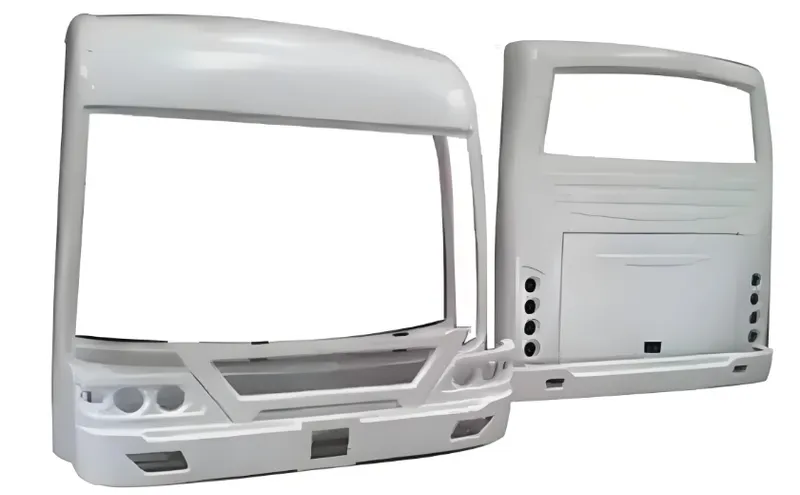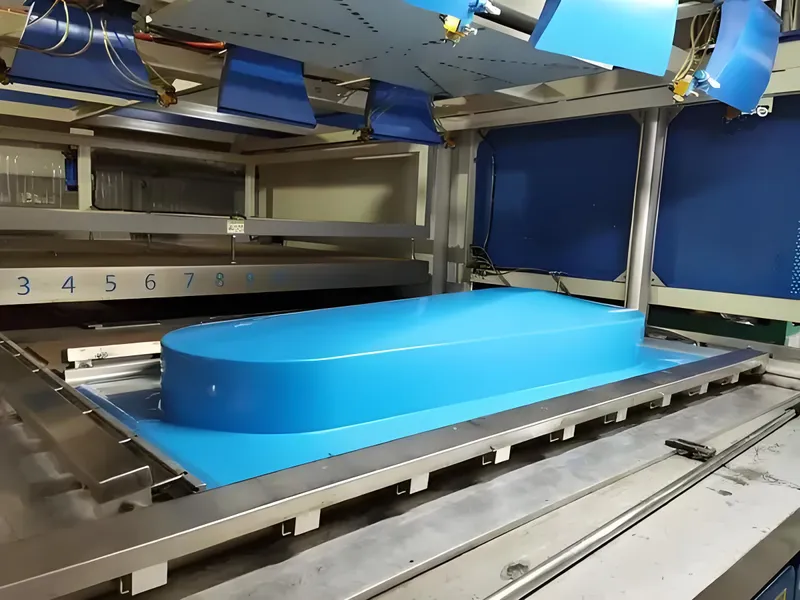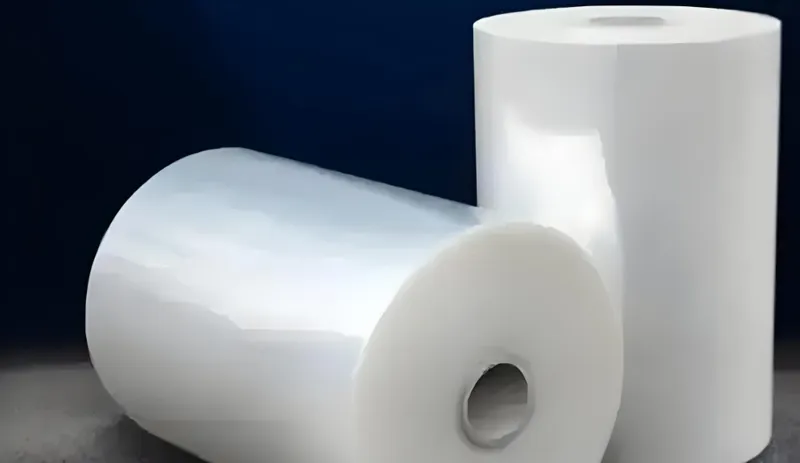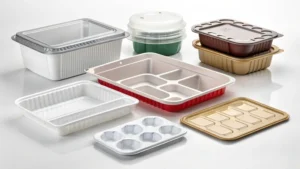
Nel mondo della termoformatura, la scelta del materiale giusto può determinare il successo del progetto. Due materiali termoplastici molto utilizzati, Policarbonato (PC)1 e Acrilonitrile Butadiene Stirene (ABS)spesso entrano in gioco. Ma cosa li distingue nel processo di termoformatura? Questa guida completa ne esplora le differenze, aiutandovi a decidere il materiale più adatto alle vostre esigenze di produzione.
Il policarbonato (PC) offre una resistenza e una trasparenza eccezionali, perfette per applicazioni complesse e ad alto impatto, mentre l'ABS offre una versatilità conveniente per pezzi più semplici e opachi.
La comprensione di queste distinzioni è fondamentale per ottimizzare il vostro processo di termoformatura2. Se avete bisogno di chiarezza, durata o convenienza, questo articolo vi guiderà attraverso le sfumature di PC e ABS.
Il PC è più costoso dell'ABS.Vero
Grazie alle sue proprietà superiori, come la trasparenza e la resistenza agli urti, il PC ha in genere un prezzo più elevato.
L'ABS non può essere utilizzato per applicazioni trasparenti.Vero
L'ABS è intrinsecamente opaco e non è quindi adatto alle applicazioni che richiedono la trasmissione della luce.
- 1. Cosa sono il policarbonato (PC) e l'acrilonitrile butadiene stirene (ABS)?
- 2. Quali sono gli scenari applicativi tipici di PC e ABS nella termoformatura?
- 3. Quali sono le fasi principali del processo di termoformatura di PC e ABS?
- 4. Come scegliere tra PC e ABS per la termoformatura?
- 5. Quali sono le tecnologie correlate a PC e ABS nella termoformatura?
- 6. Conclusione
Cosa sono il policarbonato (PC) e l'acrilonitrile butadiene stirene (ABS)?
Definizioni e principi fondamentali
- Policarbonato (PC): È un polimero termoplastico rinomato per la sua resistenza, tenacità e trasparenza ottica. Conosciuto con nomi commerciali come Lexan o Makrolon, il PC eccelle nelle applicazioni che richiedono resistenza agli urti e trasmissione della luce, come schermi di sicurezza, alloggiamenti di dispositivi medici e parti di automobili.

- Acrilonitrile Butadiene Stirene (ABS)3: Terpolimero composto da acrilonitrile, butadiene e stirene, l'ABS bilancia resistenza, durata e facilità di lavorazione. Per sua natura opaco, è il preferito per articoli accessibili e versatili come giocattoli, elettronica e interni di automobili.
Entrambi i materiali sono termoplastici, cioè possono essere riscaldati, modellati e raffreddati in nuove forme tramite termoformatura. Tuttavia, le loro proprietà uniche determinano comportamenti diversi durante il processo.

Classificazione
-
Prospettiva di processo: Sia il PC che l'ABS vengono termoformati riscaldando fogli di plastica e modellandoli con stampi. Il PC richiede un controllo preciso della temperatura a causa del suo punto di rammollimento più elevato, mentre l'ABS è più tollerante.
-
Prospettiva materiale: Il PC offre trasparenza, elevata resistenza agli urti ed eccellente formabilità, ideale per i progetti più complessi. L'ABS, opaco e con una moderata resistenza agli urti, si adatta a forme più semplici.
-
Prospettiva applicativa: Il PC è preferito per gli usi di fascia alta, come i dispositivi ottici e le apparecchiature di sicurezza, mentre l'ABS domina nei prodotti di massa, sensibili ai costi.
La termoformatura con PC richiede un controllo della temperatura meno preciso rispetto all'ABS.Falso
In realtà, il PC richiede un controllo della temperatura più preciso a causa del suo punto di rammollimento più elevato e della sua sensibilità al surriscaldamento.
Quali sono gli scenari applicativi tipici di PC e ABS nella termoformatura?
Applicazioni per PC
Il policarbonato brilla nelle applicazioni che richiedono trasparenza e durata:

-
Schermi e protezioni di sicurezza
-
Alloggiamenti per dispositivi medici
-
Lenti per fari automobilistici
-
Lenti ottiche e display
La sua chiarezza e resistenza ne fanno un punto fermo in settori come quello sanitario e automobilistico.
Applicazioni dell'ABS
L'ABS è comunemente utilizzato in:
-
Giocattoli (ad esempio, mattoncini LEGO)
-
Componenti di elettrodomestici (ad esempio, involucri di aspirapolvere)
-
Rivestimenti interni per autoveicoli
-
Involucri per elettronica di consumo
La sua economicità e versatilità di finitura lo rendono ideale per i beni di consumo.

Confronto tra pro e contro
Ecco come si posizionano il PC e l'ABS in termoformatura4:
| Aspetto | PC Pro | Contro del PC | Pro dell'ABS | ABS Contro |
|---|---|---|---|---|
| Resistenza agli urti5 | Eccezionale, ideale per usi critici per la sicurezza | Costo più elevato rispetto all'ABS | Buono, adatto all'uso generale | Inferiore a quello del PC, meno adatto a esigenze di alto impatto |
| Trasparenza6 | Naturalmente trasparente, ottimo per l'ottica | Incline a graffiarsi, può necessitare di rivestimenti | Opaco, perfetto per le finiture verniciate | Non utilizzabile per la trasmissione della luce |
| Processabilità | Alta formabilità, supporta forme complesse | Necessita di un controllo preciso della temperatura | Più facile da lavorare, intervallo di temperatura più ampio | Formabilità limitata, adatta a progetti più semplici |
| Costo7 | Costo più elevato, giustificato dalle prestazioni | - | Economico e conveniente | - |
| Resistenza chimica | Moderato, varia a seconda del grado | - | Moderato, resiste agli acidi e agli alcali | Resistenza limitata ad alcuni solventi |
Il PC eccelle nei casi in cui la chiarezza e la resistenza sono fondamentali, mentre l'ABS è la soluzione ideale per i progetti più semplici ed economici.
Il PC è più adatto alle forme complesse rispetto all'ABS.Vero
La maggiore formabilità del PC consente di realizzare disegni più profondi e più complessi rispetto all'ABS.
Quali sono le fasi principali del processo di termoformatura di PC e ABS?
Il processo di termoformatura di PC e ABS segue queste fasi, con variazioni dei parametri:

-
Pre-asciugatura: Entrambi i materiali richiedono un'essiccazione (ad esempio, 250°F per 4-6 ore) per rimuovere l'umidità e prevenire difetti come la formazione di bolle.
-
Riscaldamento: Il PC si riscalda a 350°F-375°F (177°C-190°C), l'ABS a 320°F-374°F (160°C-190°C). Il punto di rammollimento più alto del PC richiede temperature elevate.
-
Formazione: La lastra riscaldata viene sagomata su uno stampo utilizzando il vuoto o la pressione. Il PC gestisce meglio le forme complesse, mentre l'ABS si adatta a progetti meno profondi.

-
Raffreddamento: Il raffreddamento controllato determina la forma. Il maggiore ritiro del PC (0,7-1%) richiede maggiore attenzione rispetto a quello dell'ABS (0,4-0,8%).
-
Rifinitura e rifinitura: Le eccedenze vengono rifilate, il PC viene spesso lucidato per renderlo più chiaro e l'ABS viene verniciato o testurizzato.
| Fase del processo | Parametri del PC | Parametri ABS |
|---|---|---|
| Pre-essiccazione | 250°F per 4-6 ore | Simile al PC |
| Temperatura di riscaldamento | 350°F-375°F | 320°F-374°F |
| Tasso di restringimento | 0,7-1% | 0,4-0,8% |
| Formabilità | Alto (allungamento 100-150%) | Moderato (allungamento 20-50%) |
Spiegazione della compatibilità dei materiali
-
Formabilità: L'allungamento del PC (100-150%) consente di eseguire trafile profonde, mentre quello dell'ABS (20-50%) lo limita a forme più semplici.
-
Impatto del restringimento: Il ritiro più elevato del PC richiede regolazioni precise della progettazione; il tasso più basso dell'ABS semplifica questa operazione.
-
Finitura superficiale: La trasparenza del PC richiede una protezione contro i graffi, mentre la superficie opaca dell'ABS eccelle con le finiture.
L'ABS richiede temperature di formatura più elevate rispetto al PC.Falso
In realtà, il PC richiede temperature di formatura più elevate a causa del suo punto di rammollimento più alto.
Come scegliere tra PC e ABS per la termoformatura?
Lista di controllo per la progettazione
-
Per PC:
-
Pre-essiccare a 250°F per 4-6 ore.
-
Conto per 0,7-1% restringimento8.
-

-
Riscaldare a 350°F-375°F, regolando la complessità.
- Proteggere dai graffi (ad es. rivestimenti).
-
Per l'ABS:
-
Pre-asciugare per rimuovere l'umidità.
-
Progettato per un ritiro di 0,4-0,8%.
-
Utilizzare la pittura o la testurizzazione per l'estetica.
-
Mantenere i progetti semplici a causa della minore formabilità.
-
Selezione del processo Processo decisionale
Seguite questo albero decisionale:
-
Avete bisogno di trasparenza? Sì → PC; No → Avanti.
-
Alto Resistenza agli urti9 critico? Sì → PC; No → Avanti.
-
Il costo è una priorità? Sì → ABS; No → Avanti.
-
Sono richieste forme complesse? Sì → PC; No → ABS.
Questo assicura che la scelta sia in linea con gli obiettivi del progetto.
Il PC è sempre la scelta migliore per la termoformatura.Falso
Sebbene il PC offra proprietà superiori in alcune aree, l'ABS è più economico e più facile da lavorare per molte applicazioni.
Quali sono le tecnologie correlate a PC e ABS nella termoformatura?
- Altri materiali di termoformatura: Alternative come PET, PP, PS e PVC offrono proprietà uniche per esigenze specifiche.

-
Processi complementari: Lo stampaggio a iniezione e l'estrusione si adattano a diverse scale di produzione o geometrie.
-
Tecnologie a monte e a valle: La sintesi dei materiali, gli additivi e la post-elaborazione (ad esempio, la verniciatura) migliorano i risultati.
L'esplorazione di questi elementi può affinare la vostra strategia di termoformatura10.
Conclusione
La scelta tra PC e ABS nella termoformatura si basa sulla comprensione delle loro differenze. La resistenza e la chiarezza del PC si adattano ad applicazioni complesse di fascia alta, mentre l'economicità e la facilità d'uso dell'ABS si adattano a progetti più semplici e sensibili ai costi. Valutando la trasparenza, la resistenza agli urti, la formabilità e il costo, è possibile scegliere il materiale ideale. Applicate queste conoscenze per migliorare i vostri risultati di produzione.
-
Scoprite i vantaggi del policarbonato (PC) nella termoformatura per comprenderne la resistenza e la trasparenza per applicazioni ad alto impatto. ↩
-
La comprensione del processo di termoformatura è fondamentale per ottimizzare la selezione dei materiali e ottenere i risultati desiderati. ↩
-
Scoprite come l'ABS si distingue tra i materiali termoplastici per la sua economicità e versatilità in varie applicazioni. ↩
-
Imparate a conoscere le tecniche di termoformatura per capire come materiali come il PC e l'ABS vengono modellati per varie applicazioni. ↩
-
La comprensione della resistenza agli urti dei materiali è fondamentale per le applicazioni critiche per la sicurezza. Esplorate questo link per saperne di più sulle loro differenze. ↩
-
La trasparenza è fondamentale per le applicazioni che richiedono la trasmissione della luce. Scoprite le differenze tra PC e ABS in questa risorsa informativa. ↩
-
Le considerazioni sui costi sono essenziali per la definizione del budget di progetto. Questo link fornisce informazioni sugli aspetti finanziari dell'utilizzo del PC rispetto all'ABS. ↩
-
La comprensione dei tassi di ritiro è fondamentale per una progettazione e una produzione accurate nella termoformatura. Esplorate questo link per avere informazioni dettagliate. ↩
-
Conoscere i vantaggi di un'elevata resistenza agli urti può aiutarvi a scegliere i materiali giusti per i vostri progetti, garantendo durata e prestazioni. ↩
-
L'esplorazione delle strategie di termoformatura può migliorare l'efficienza produttiva e la selezione dei materiali, portando a migliori risultati di progetto. ↩







